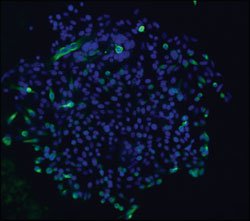Study suggests presence of stem-like cells in uveal melanoma
Researchers found cell lines derived from a primary uveal melanoma contained a population of cancer stem-like cells that were able to undergo self-renewal and were resistant to chemotherapy.
 Helen Kalirai |
Evidence suggests uveal melanoma has self-renewing stem-like cells that drive tumor growth and metastasis, a speaker said at the Association for Research in Vision and Ophthalmology meeting in Fort Lauderdale, Fla.
Deeper insight into the pathogenesis of uveal melanoma may aid the development of therapeutic agents that target cancer stem cells and prevent further growth of the primary tumor and development of metastatic lesions, Helen Kalirai, BSc, PhD, said.
Over the last decade, the concept of cancer stem cells has gradually gained acceptance based on observed similarities between normal tissue-specific stem cells and cancer cells. In addition, signaling pathways that regulate survival and self-renewal of normal tissue-specific stem cells have been shown to be involved in tumorigenesis.
“The cancer stem cell is believed to be the driving force behind the growth of both the primary tumor and metastatic lesions,” Dr. Kalirai said. “Current therapies tend to target the rapidly dividing cells of the tumor. However, this would then leave the cancer stem cell intact, due to its relative quiescence, allowing the primary tumor to regrow and metastatic lesions to occur.
“It’s essential that we’re able to effectively characterize these cancer stem cells and the signaling pathways that control them if we’re to develop effective cancer stem cell inhibitors that, maybe in combination with other current therapies, can eradicate the tumor, prevent tumor recurrence and also distant metastases,” she said.
“To date, studies of this kind in uveal melanoma have been hampered by problems associated with the acquisition and long-term culture of primary human uveal melanoma cells and have been slow because it has been hard to identify cancer stem cells unequivocally,” Dr. Kalirai said.
Investigating cell lines
Dr. Kalirai and colleagues used cell lines derived from a primary uveal melanoma and a metastatic liver lesion of one patient. They wanted to determine if, as in other cancer types, uveal melanoma cell lines possess a cellular hierarchy such that they retain a population of self-renewing tumorigenic stem-like cells.
 Fluorescence image of a Mel270 holoclone showing heterogeneous HMB45 protein expression (green) and nuclei stained with DAPI (blue). Image: Kalirai H |
The cell lines derived from the primary uveal melanoma, Mel270, and the metastatic liver lesion, Omm2.5, were investigated using a variety of clonogenic assays to assess cellular self-renewal and differentiation.
The cultured tumor cells and metastatic cells showed three distinct clonal morphologies in adherent culture: holoclones, or primitive cells; meroclones, or cells of moderate complexity; and paraclones, or differentiated cells, Dr. Kalirai said. In both cell populations, holoclones were large colonies of tightly packed, highly proliferative small cells with low expression of the markers of differentiation, MelanA/HMB45. Paraclones were small colonies of larger, flatter cells with limited proliferative potential and high levels of MelanA/HMB45 expression.
By virtue of their heterogeneity, the holoclones could be serially passaged (more than 10 generations) to produce colonies of all three morphological types. In contrast, paraclones could be passaged for only a couple of generations to produce further paraclones.
Mel270 and Omm2.5 cells also produced melanomaspheres when grown at clonal density in nonadherent culture. The spheres could be passaged to produce more melanomaspheres, indicating their ability to undergo self-renewal, and similarly to cells grown in adherent culture, demonstrate phenotypic and antigenic heterogeneity, Dr. Kalirai said. Mel270 and Omm2.5 holoclones and melanomaspheres also showed expression of Notch1, PAX 3, SOX10 and SNAI2, markers associated with multipotent cells of the neural crest lineage.
Mel270 cells were treated with cisplatin, a chemotherapeutic agent, to gauge selective resistance to chemotherapy. Results showed that cells surviving cisplatin treatment produced a significantly higher percentage of holoclones than untreated cells, Dr. Kalirai said.
“This suggests that a more primitive population is able to survive chemotherapy,” she said.
Dr. Kalirai concluded by saying, “We have uveal melanoma cell lines that contain a population of cancer stem-like cells that are able to undergo self-renewal and are resistant to chemotherapy.” – by Matt Hasson

- Helen Kalirai, BSc, PhD, can be reached at Division of Pathology, University of Liverpool, 6th Floor Duncan Building, Daulby Street, Liverpool L69 3GA, UK; 44-151-706-4869; e-mail: H.Kalirai@liverpool.ac.uk.

![]()
Cancer stem cells (CSCs) are a relatively new concept whose existence is somewhat debated. CSCs were first observed in 1997 in a subpopulation of leukemic cells. CSCs are the stem cells that theoretically produce all of the cancer cells in a specific cancer. These specialized cells have the capacity for self-renewal and differentiation into the specific cancer cell types and are speculated to be the source for tumor resistance, recurrence and metastasis because of their survival ability. Focused therapies targeted at CSCs are hoped to improve cancer control.
In this report, Dr. Kalirai searched for CSCs in uveal melanoma. They studied one case of melanoma cells from the eye and liver (metastasis). Based on observations of a primitive line of cells (holoclones) that could reproduce themselves and more differentiated cells (meroclones and paraclones), they suggest that these could represent CSC-like cells in uveal melanoma. These hardy cells survived cisplatin (chemotherapy) to continue growth and renewal. The authors propose that targeting agents at these cells could provide a new avenue for therapy for uveal melanoma. As shown in this investigation, understanding the basic growth strategy of uveal melanoma could ultimately lead to improved therapies focused on the stem cell of origin.
– Carol Shields, MD
Ocular Oncology
Service, Wills Eye Institute, Philadelphia
